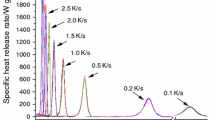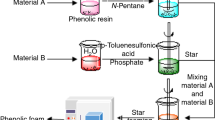Abstract
For further progress of novel foam core particleboards, their fire performance was examined with cone calorimetry tests (ASTM E 1354-11a). Specimens with varying surface layer thicknesses, foam densities (polystyrene foam), and processing temperatures were tested. Using the initially recommended cone irradiance of 35 kW/m2, different flammability parameters were measured. In comparison to particleboards, the foam core panels generally had much higher heat release rates, somewhat higher heat of combustion and much higher smoke production due to the EPS-foam component of tested panels. The time to ignition and total heat release did not vary significantly among the samples, although certain trends could be explained. The effects of variations in specimen foam densities and processing temperatures on the flammability parameters were not very significant. However, the flammability properties improved towards that of the reference particleboard as the surface layer thickness increased from 3 to 5 mm.
Zusammenfassung
Im Rahmen der Weiterentwicklung neuartiger Spanplatten mit Schaumkern wurde das Abbrandverhalten mit Hilfe des Cone Calorimeter Tests (ASTM E 1354-11a).untersucht. Proben mit unterschiedlichen Decklagen-Dicken, Schaumkern-Dichten (Polystyrol-Schaum) und Presstemperaturen wurden geprüft. Bei Anwendung der empfohlenen Strahlungsintensität von 35 kW/m² wurden unterschiedliche Entflammbarkeiten festgestellt. Im Vergleich zu normalen Spanplatten zeigten die Schaumkernspanplatten aufgrund der EPS-Schaumanteile eine wesentlich höhere Wärmefreisetzungsrate, eine leicht erhöhte Verbrennungswärme sowie eine stark erhöhte Rauchentwicklung. Die Zeit bis zur Entzündung sowie die gesamte Wärmefreisetzung unterschieden sich nicht signifikant zwischen den Proben, wobei dennoch bestimmte Trends erklärbar waren. Die durch die Variation der Schaumkerndichten und Presstemperaturen bei der Herstellung verursachten Unterschiede waren nicht signifikant. Mit einer Zunahme der Decklagendicke von 3 mm auf 5 mm näherte sich die Entflammbarkeit der Schaumkern-Spanplatten an die Entflammbarkeit der als Referenz verwendeten normalen Spanplatten an.









Similar content being viewed by others
References
ASTM E 1354-11a (2011) Standard test method for heat and visible smoke release rates for materials and products using an oxygen consumption calorimeter. ASTM International, West Conshohocken, PA
Babrauskas V, Parker WJ (1987) Ignitability measurements with the cone calorimeter. Fire Mater 11:31–43
Bakhtiyari S, Taghi–Akbari L, Barikani M (2010) The effective parameters for reaction–to–fire properties of expanded polystyrene foams in bench scale. Iran Polym J 19:27–37
Collier PCR, Baker GB (2004) Improving the fire performance of polystyrene insulated panel in New Zealand. New Zealand Fire Service Commission research report number 45. ISBN number 1-877349-08-9
Cooke GME (2004) Stability of lightweight structural sandwich panels exposed to fire. Fire Mater 28:299–308
Dietenberger MA (2002) Update for combustion properties of wood components. Fire Mater 26:255–267
Dietenberger MA (2012) Pyrolysis kinetics and combustion of thin wood using an advanced cone calorimetry test method. J Therm Anal Calorim 109:1215–1228
Dietenberger MA, Grexa O (2004) Ignitability of materials in transitional heating regimes. In: Proceedings of 5th international scientific conference of wood & fire safety. Slovak Republic, pp 31-41
Gurman JL, Baier L, Levin BC (1987) Polystyrenes: A review of the literature on the products of thermal decomposition and toxicity. Fire Mater 11:109–130
Hagge MJ, Bryden KM, Dietenberger MA (2004) Effect of backing board materials on wood combustion performance. In: Proceedings of 5th international scientific conference of wood & fire safety. Slovak Republic, pp 51–58
Harada T (2001) Time to ignition, heat release rate and fire endurance time of wood in cone calorimeter test. Fire Mater 25:161–167
Hirschler MM (1992) Heat release from plastics materials. In: Babrauskas V, Grayson SL (eds) Heat release in fires. Elsevier, New York, pp 418–419
Karlsson K, Åström T (1997) Manufacturing and applications of structural sandwich components. Compos Part A Appl Sci Manuf 28:97–111
Luedtke J (2011) Entwicklung und Evaluierung eines Konzepts für die kontinuierliche Herstellung von Leichtbauplatten mit polymerbasiertem Kern und Holzwerkstoffdecklagen. Dissertation. Hamburg University, Germany. http://ediss.sub.uni-hamburg.de/volltexte/2011/5470/
Mouritz AP, Mathys Z, Gibson AG (2006) Heat release of polymer composites in fire. Compos Part A Appl Sci Manuf 37:1040–1054
Östmann BA-L, Tsantaridis LD (1993) Smoke data from the cone calorimeter for comparison with the room fire test. Fire Mater 17:191–200
Petrella RV (1994) The assessment of full–scale fire hazards from cone calorimeter data. J Fire Sci 12:14–43
Schartel B, Hull TR (2007) Development of fire-retarded materials-Interpretation of cone calorimeter data. Fire Mater 31:327–354
Schartel B, Bartholmai M, Knoll U (2005) Some comments on the use of cone calorimeter data. Polym Degrad Stab 88(3):540–547
Scudamore MJ, Briggs PJ, Prager FH (1991) Cone calorimetry-a review of tests carried out on plastics for the association of plastic manufacturers in Europe. Fire Mater 15:65–84
Shalbafan A, Luedtke J, Welling J, Thoemen H (2012a) Comparison of foam core materials in innovative lightweight wood-based panels. Eur J Wood Prod 70:287–292
Shalbafan A, Welling J, Luedtke J (2012b) Effect of processing parameters on mechanical properties of lightweight foam core sandwich panels. Wood Mater Sci Eng 7:69–75
Shalbafan A, Luedtke J, Welling J, Fruehwald A (2012c) Physiomechanical properties of ultra-lightweight foam core particleboard: Different core densities. Holzforschung. doi:10.1515/hf-2012-0058
Troitzsch J (1990) International plastics flammability handbook: principles—regulations—testing and approvals, 2nd edn. Hanser, Munich
White RH, Dietenberger MA (2004) Cone calorimeter evaluation of wood products. In: Proceedings of 15th annual BCC conference flame retardancy. Stamford, Connecticut, pp 331–342
White RH, Dietenberger MA (2010) Fire safety of wood construction. In: Wood handbook: wood as an engineering material. Forest Products Laboratory, Department of Agriculture Forest Service, Madison, WI, pp 18-1–18-22
Zenkert D (1997) The handbook of sandwich construction. Cradley Heath: Engineering Materials Advisory, UK
Acknowledgments
Ali Shalbafan is indebted to the Ministry of Science, Research and Technology of Iran for his Ph.D scholarship. The authors acknowledge the work of laboratory technician, Ms. Anne Fuller and the support of FPL Fire Safety team leader, Dr. Robert White, to obtain the cone calorimeter data. Special thanks to Professor Joerg B. Ressel at Hamburg University and Dr. Jan Luedtke at Johann Heinrich von Thünen Institute for their valuable contribution to this paper.
Author information
Authors and Affiliations
Corresponding author
Rights and permissions
About this article
Cite this article
Shalbafan, A., Dietenberger, M.A. & Welling, J. Fire performances of foam core particleboards continuously produced in a one-step process. Eur. J. Wood Prod. 71, 49–59 (2013). https://doi.org/10.1007/s00107-012-0653-4
Received:
Published:
Issue Date:
DOI: https://doi.org/10.1007/s00107-012-0653-4




